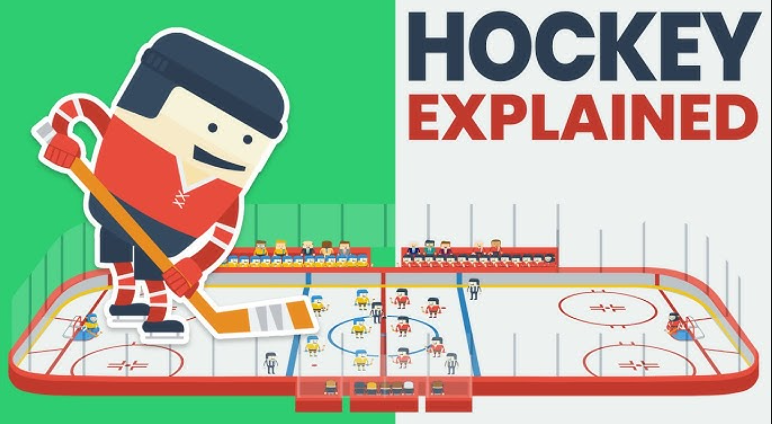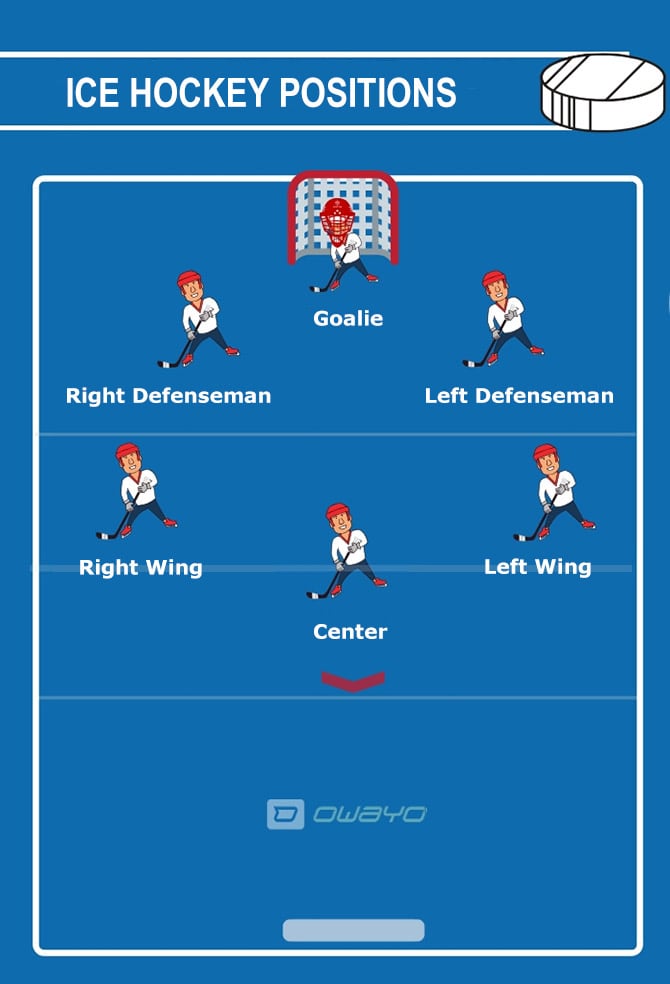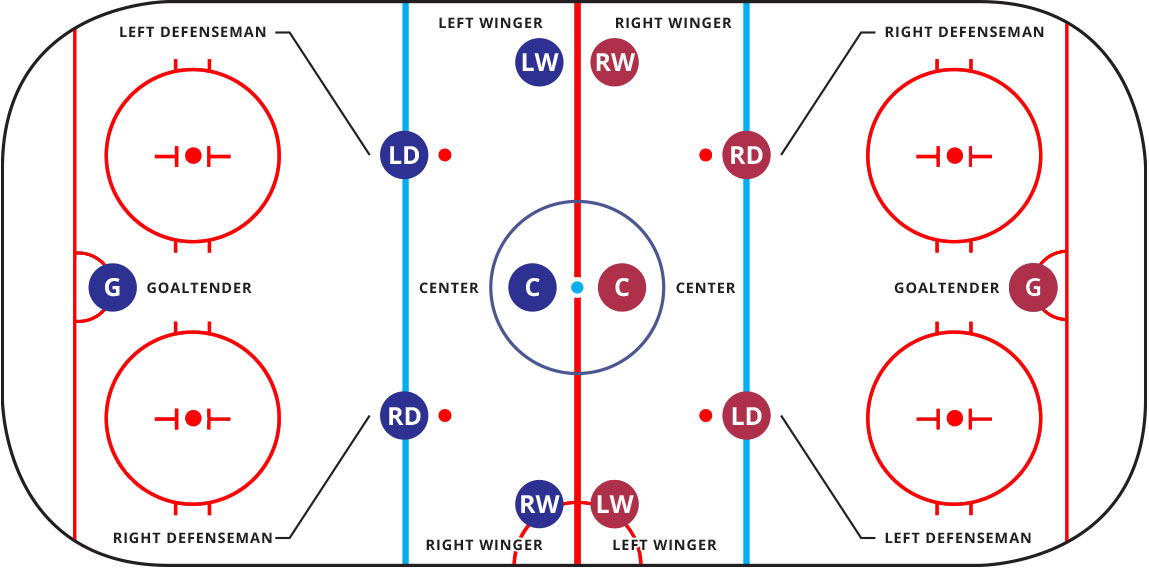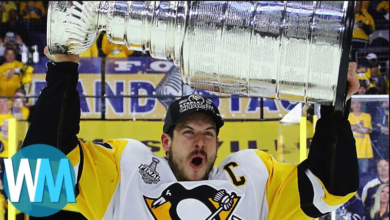
Different Hockey Positions: Key Roles & Winning Strategies
Hockey positions include forwards, defensemen, and goaltenders. Each role plays a vital part in the game’s strategy and outcome.
In hockey, players take on specific roles that are crucial for team coordination and success on the ice. The forwards, usually consisting of a centre and two wingers, focus on offence, aiming to score goals and create plays. Defensemen, positioned behind the forwards, are tasked with preventing the opposing team from scoring by protecting their zone, supporting the goalie, the last line of defence, and blocking shots to prevent goals.
These positions require skill, speed, and tactical understanding to outmanoeuvre opponents and contribute to the team’s victory. Understanding these roles is essential for appreciating the complexities of hockey and the diverse skill set each player brings to the ice.

Credit: www.owayo.com
Contents
- 1 Ice Battle Basics: Key Player Positions
- 2 Masters Of Offense: Forwards At Work
- 3 The Sixth Skater: Understanding The Utility Player
- 4 Guardians Of The Goal: Unique Skills Of A Goaltender
- 5 Blueline Strategists: Defensemen’s Crucial Plays
- 6 The Goal Scoring Trio: Forwards’ Offensive Tactics
- 7 Special Teams: Power Play And Penalty Kill
- 8 Team Strategy: Formations And Plays
- 9 Training For Excellence: Developing Players
- 10 Winning The Game: The Role Of Coaching
- 11 Conclusion
Ice Battle Basics: Key Player Positions
Understanding hockey positions is like decoding a strategic game on ice. Every player has a crucial role; success depends on how well these roles are fulfilled. Dive into hockey and explore the key positions that shape the game.
The Goalie: Last Line Of Defense
The goalie stands as the ultimate protector of the net. They are a formidable force equipped with pads, gloves, and blockers. Goalies must possess sharp reflexes and a keen sense of positioning to keep the puck out.
- Blocks shots from entering the goal
- Keeps the puck in sight at all times
- Coordinates with defensemen to fortify the net
Defensemen: The Defensive Backbone
Defensemen are the line between opposing players and their goalie. They are the defensive backbone, thwarting attacks, clearing the puck from dangerous areas, and kickstarting offensive plays with precision passes.
| Role of Defensemen | Skills Required |
| Guard opposing team’s forwards | Strong skating, positioning |
| Block shots and passes | Quick reflexes, physical play |
| Launch offensive drives | Passing accuracy, awareness |
By understanding these positions, fans gain a greater appreciation for the strategy behind every play.
Masters Of Offense: Forwards At Work
The heart of any hockey team’s offence lies with its forwards. These players are the driving force behind scoring goals. Their skill sets vary, from exceptional puck handling to blazing speed. Let’s dive into the world of forwards to understand their crucial roles.
Centre: The Playmaker
The centre skates across the entire ice surface. This player is a versatile powerhouse adept at both offence and defence. Anchoring the forward line, the centre supports wingers and often takes face-offs. Centres must excel in reading the game and dishing out precise passes.
- Face-off dominance: Wins crucial possession of the puck
- Vision: Sees passing lanes and sets up scoring chances
- Defensive aid: Assists defensemen in protecting the goal
Wingers: Speed And Precision
Split into two positions, left and right, wingers are key attackers in offensive plays. Their main objectives are to assist the centre and to score. Known for their acceleration and sharp shooting, these players are often the first to unleash a puck towards the net.
| Winger Position | Main Skills |
| Left Wing |
|
| Right Wing |
|
The Sixth Skater: Understanding The Utility Player
Every hockey team has a secret weapon known as the sixth skater. This player, often called the utility player, carries the team’s versatility. They may not always grab the headlines, but their role is vital for a team’s success. Let’s dive into what makes the utility player so essential and explore the depths of their versatility and strategic uses on the ice.
Versatility On Ice
The utility player is like a Swiss Army knife for the hockey team. They fill any position, adapt to different game situations, and quickly switch roles. Here are vital traits:
- Adaptable skills: Capable of playing both offence and defence.
- High hockey IQ: They understand every facet of the game.
- Physical fitness: Endurance to sustain energy in any role.
Imagine a situation where a defence player is in the penalty box. Our utility player jumps in, seamlessly taking their place. They help the team stay strong, no matter who is on the ice.
Strategic Use In Special Situations
Coaches have a strategic ace with the utility player. They play them in particular situations to gain an edge. Here are some scenarios:
- Penalty kill: Fills in defensive gaps.
- Power play: Adds an offensive threat.
- Last-minute goals: Utility players can increase scoring chances.
Their ability to assume multiple roles means a coach can maintain optimal team balance. Say the team needs to protect a lead; the utility player drops back, strengthening the defence. Need to ramp up the attack? They move forward, joining the offensive line. Their impact is subtle yet significant.
Guardians Of The Goal: Unique Skills Of A Goaltender
Imagine a fortress with a single, agile guardian. That’s the hockey net with the goaltender. Goaltenders are the backbone of a hockey team’s defence. They possess a unique skillset, blending incredible reflexes with mental toughness. Let’s dive into what makes these guardians so pivotal on the ice.
Reflexes And Positioning
The first line of defence in hockey is a goaltender’s reflexes. Quick reactions can be the difference between a save and a goal. Proper positioning is also crucial. A goaltender must master angles to cut down the shooter’s options. Below are key attributes that highlight a goalie’s expertise in reflexes and positioning:
- Hand-eye coordination: Critical for catching or deflecting the puck.
- Flexibility: Enables the sudden, acrobatic saves.
- Footwork: Vital for timely side-to-side movements.
- Anticipation: Reading the play to predict shot direction.
Psychological Fortitude
Mental strength shapes a goaltender’s success. The ability to remain calm under pressure is essential. Focus and confidence help a goalie bounce back from any setbacks. Consider these mental aspects vital for any goaltender:
- Resilience: Quickly recovering from goals allowed.
- Concentration: Maintaining focus amidst game chaos.
- Competitiveness: The drive to outwit opposing players.
- Consistency: Dependable performance game after game.
Blueline Strategists: Defensemen’s Crucial Plays
In the heart-pounding world of hockey, defensemen stand as sentinels on the blue line. With each game, they orchestrate plays that are nothing short of crucial. Their role is multifaceted; they are the bulwark against oncoming attacks and the starting point of offensive manoeuvres. Let’s delve into the critical plays that define the artistry of defensemen on the icy stage.
Blocking Shots And Passing
Defensemen shine when bullets come flying. With sheer determination, they put themselves between the puck and the goal. Blocking shots is about courage and timing. These players read the game, anticipate trajectories, and make split-second decisions to deflect potential goals.
- Strategic Positioning: Know where to be at the right time.
- Quick Reflexes: React rapidly to incoming pucks.
- Sacrifice: Put team success above all.
But their role isn’t just defensive. Defensemen master the act of passing to turn defence into attack. Crisp, precise passes break out from their zone and feed their forwards to strike.
- Analyze the play.
- Find the best passing lanes.
- Execute with accuracy.
Physicality And On-ice Vision
Beyond blocking and passing, defensemen use their bodies. They engage in battles for puck control, asserting their physical presence. They nudge, check, and steer opponents from scoring zones, dominating their territory.
| Physical Skills | On-Ice Vision |
| Strong Checking | Anticipate Play Developments |
| Effective Use of Body | Identify Passing Options |
| Stamina and Strength | Communicate with Teammates |
Their on-ice vision guides the team, spotting movements before they unfold. Defensemen must think ahead, foresee actions, and make the right calls. These blueline strategists are the backbone of a formidable hockey team, impacting the game in ways that resonate long after the final buzzer rings.
The Goal Scoring Trio: Forwards’ Offensive Tactics
In hockey, goals are the golden currency, and the forwards are the mint masters. Three players, each with a knack for the net, work in a unique harmony to light the lamp and excite the crowd. This trio combines brawn, brains, and blades to outsmart the opposition. Dive into the nuances of their offensive juggernaut, where tactics blend with sheer talent to dominate the scoreboard.
Creating Scoring Opportunities
The art of creating scoring chances lies at the heart of every forward line’s purpose.
- We were cycling the puck to disorient defences.
- We are utilizing sharp passes to open up shooting lanes.
- They were forcing turnovers through aggressive forechecking.
Effective forwards anticipate each other’s moves, keeping goalies guessing and defences scrambling.
Combination Of Speed And Strategy
The most lethal forwards blend speed with a strategic mindset.
- They were breaking fast on counters, exploiting any defensive lapses.
- It is choosing the right moment to accelerate or decelerate creates space.
- Clever positioning to receive passes and convert chances.
Mastering this combination forces opponents to respect the forward’s every move, leading to more scoring opportunities.
Special Teams: Power Play And Penalty Kill
In the fast-paced world of hockey, special teams dictate critical game moments. Understanding these elements is critical to a team’s success, whether seizing an advantage during a power play or defending against one while shorthanded. Let’s dive into the intricate strategies and formations that comprise the power play and penalty kill units.
Man-advantage Strategy
When a team gains a man advantage, they deploy their best offensive players to capitalize on the opportunity. The objective is clear: score a goal. A team typically arranges itself into specific formations aiming to maximize scoring chances:
- The Umbrella: Three players form a triangle, offering high-shot opportunities
- The Overload: Players swarm one side to confuse the defence and create openings
- The 1-3-1 Setup: Optimizes passing lanes and expands the defence
Efficient puck movement and precision are the backbones of a successful power play. Players must be agile, make quick decisions, and flawlessly execute passes to breakthrough stout defensive fronts.
Defensive Formation During Shorthanded Play
Conversely, a penalty kill demands brilliant, disciplined defence. Key focus areas include:
- Blocking shots
- Clearing the puck
- Interrupting passing lanes
Defensive formations such as the Box and the Diamond are often employed. The Box enables teams to protect the net’s front and sides. Two players position themselves close to the goalie and two near the blue line, creating a box shape. The Diamond is similar but with one player positioned higher up, aiming to pressure the point player and disrupt potential shots or passes.
Skilful penalty killing can prevent a score and swing momentum in favour of the shorthanded team. Strong communication and stamina ensure that players effectively rotate and cover vital areas until full strength is restored.

Credit: www.hockeymonkey.com
Team Strategy: Formations And Plays
In the fast-paced game of hockey, a team’s success hinges on its strategic formations and plays. Each position on the ice is crucial in executing these game plans. Whether a team is defending its zone or pressing the attack, understanding and implementing formations and plays like the Breakout, Forecheck, and Backcheck can make all the difference in securing a win.
The Breakout
At its core, the Breakout is a team’s initial move from defence to offence. It’s the strategy to exit the defensive zone and start an attack. Let’s break down the essentials:
- Puck Control: Defensemen must handle the puck with care.
- Player Positioning: Forwards align to receive passes.
- Communication: Players must constantly talk to each other.
A successful Breakout depends on swift passes and well-timed skating. The goal is to move the puck away from danger and towards the opponent’s goal. Teams often practice various Breakout drills to improve coordination and speed.
The Forecheck And Backcheck
Forechecking and backchecking are both critical to a team’s defensive strategy. These techniques pressure the opposing team, aiming to reclaim puck possession.
| Forecheck | Backcheck |
| Applied in the offensive zone | Applied when returning to defence |
| Forwards lead the charge | All players contribute |
| Objective: disrupt the Breakout | Objective: swiftly transition to defence |
Forechecking involves aggressive forward play to prevent the opposing team from organizing an attack. In contrast, backchecking requires players to skate hard towards their zone to thwart the opponents’ offence. Proper execution of both can give a team explicit control of the game’s pace.
Training For Excellence: Developing Players
The journey to hockey greatness begins with rigorously mastering the proper techniques and rigorous training. Whether you’re forward scoring goals or a goalie blocking them, honing your craft is essential. Skilled players don’t just happen overnight; they are moulded through focused training for their respective positions. This section shows how upcoming hockey stars can develop into experts on the ice.
Skills For Each Position
Different positions in hockey require unique skill sets. Here’s how players can train for excellence:
- Forwards: Work on skating speed, stickhandling, and accurate shooting.
- Defensemen: Improve body positioning, poke checking, and starting quick transitions.
- Goalkeepers: Focus on reflexes, puck tracking, and correct stance.
Physical And Mental Training
To excel, players need both physical prowess and mental strength. Physical conditioning and mental preparation go hand in hand.
| Physical Training Elements | Mental Training Techniques |
|
|
Blending physical drills with mental techniques can help players reach peak performance levels. Regular practice ensures these elements become second nature on game day.
Winning The Game: The Role Of Coaching
Winning the game often hinges on the strategic moves and decisions made by the coaching staff. A hockey coach is the mastermind behind the team, crafting game-winning strategies and ensuring that every player is utilized to their fullest potential. Like a chess grandmaster, a successful hockey coach must understand their team’s and opponents’ strengths and weaknesses. Let’s dive into the coach’s integral roles through line changes, match-ups, and in-game tactics.
Line Changes And Match-ups
Effective line changes and match-ups are crucial components of a coach’s strategy. A well-timed line change can mean the difference between scoring a crucial goal and conceding one. Coaches must read the game flow rapidly and make adjustments on the fly.
- Quick shifts keep players fresh and focused.
- Special teams are deployed for power plays and penalty kills.
- Strategic pairings counteract the opponent’s top talent.
A coach’s insight into player stamina and chemistry dictates when to swap lines. Anticipating the opposition’s moves allows for the tactical advantage of favourable match-ups, giving the team an edge at critical moments.
In-game Tactics And Adjustments
In-game tactics and adjustments reveal the dynamic skillset of a top-tier coach. Every game presents a unique set of challenges that must be met with precision and adaptability. Coaches must read the game and alter tactics accordingly.
- Analyze and exploit the weaknesses of the opponents.
- Adjust defensive formations based on the attacking pressure.
- Call timeouts to strategize and halt opponent momentum.
Swift and decisive adjustments can rejuvenate a struggling team or protect a lead. The ability to make and effectively communicate these changes to the players could make all the difference in securing a victory on the ice.
Conclusion
Understanding the different positions in hockey is fundamental for appreciating the sport’s strategic depth. Each role is vital, from the fast-paced action of forwards to the steadfast defensemen and the reflexive prowess of goalies. Embrace the synergy on the ice; it makes hockey the thrilling game fans love.
